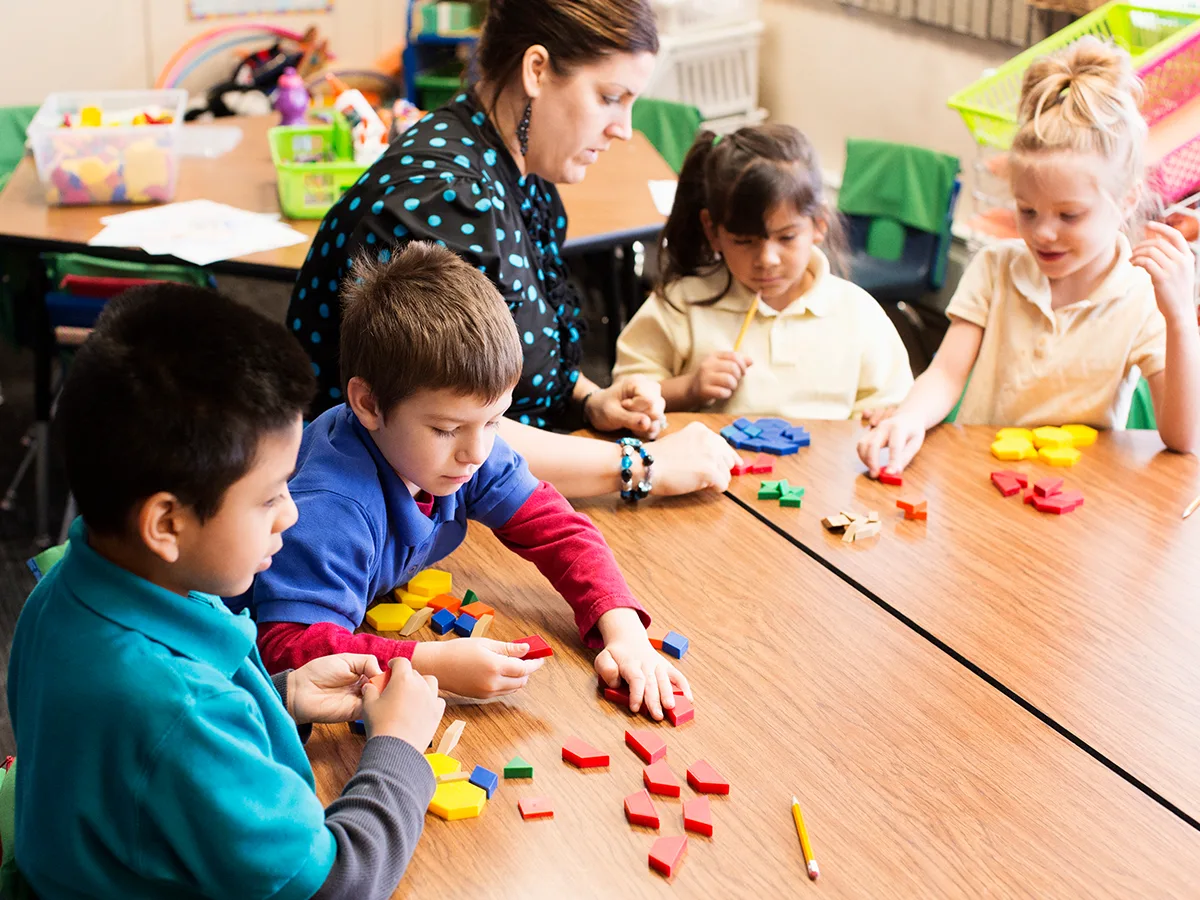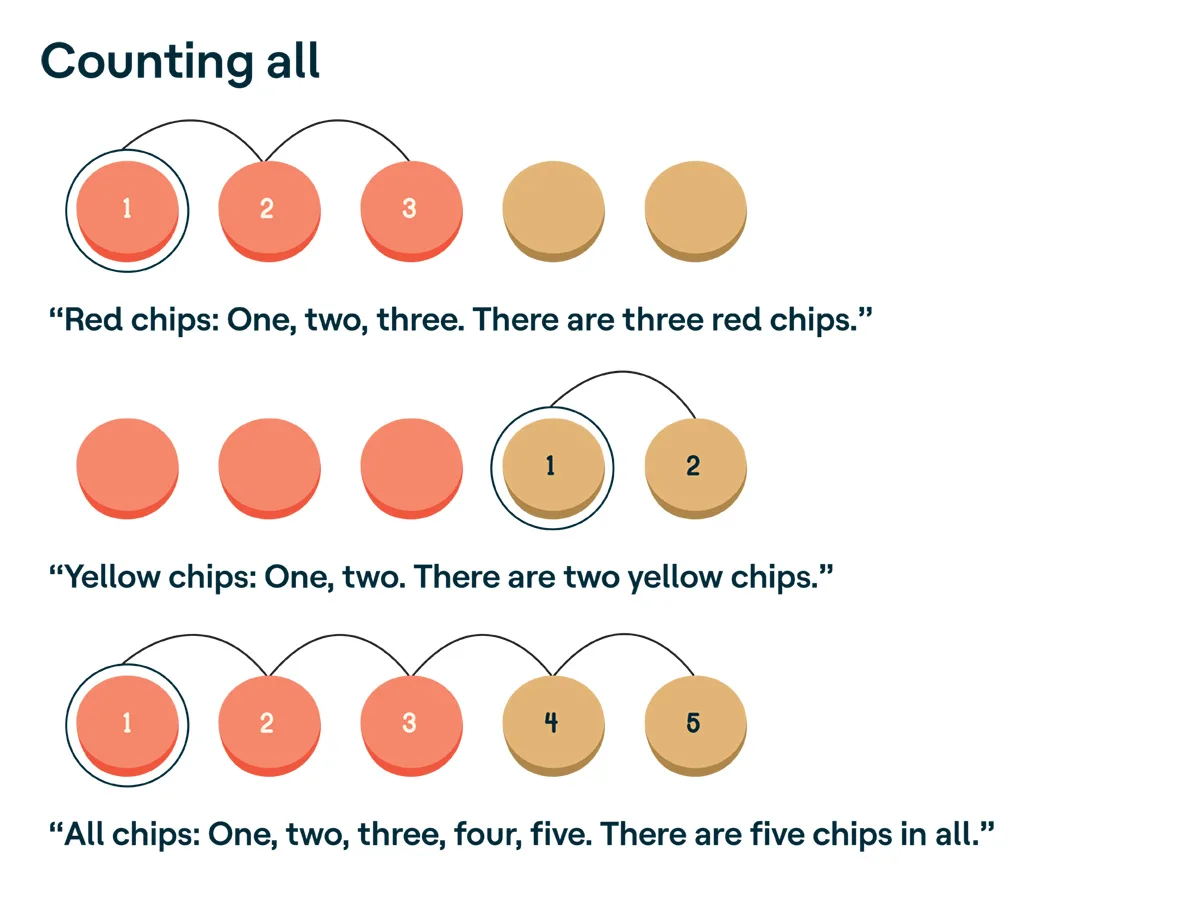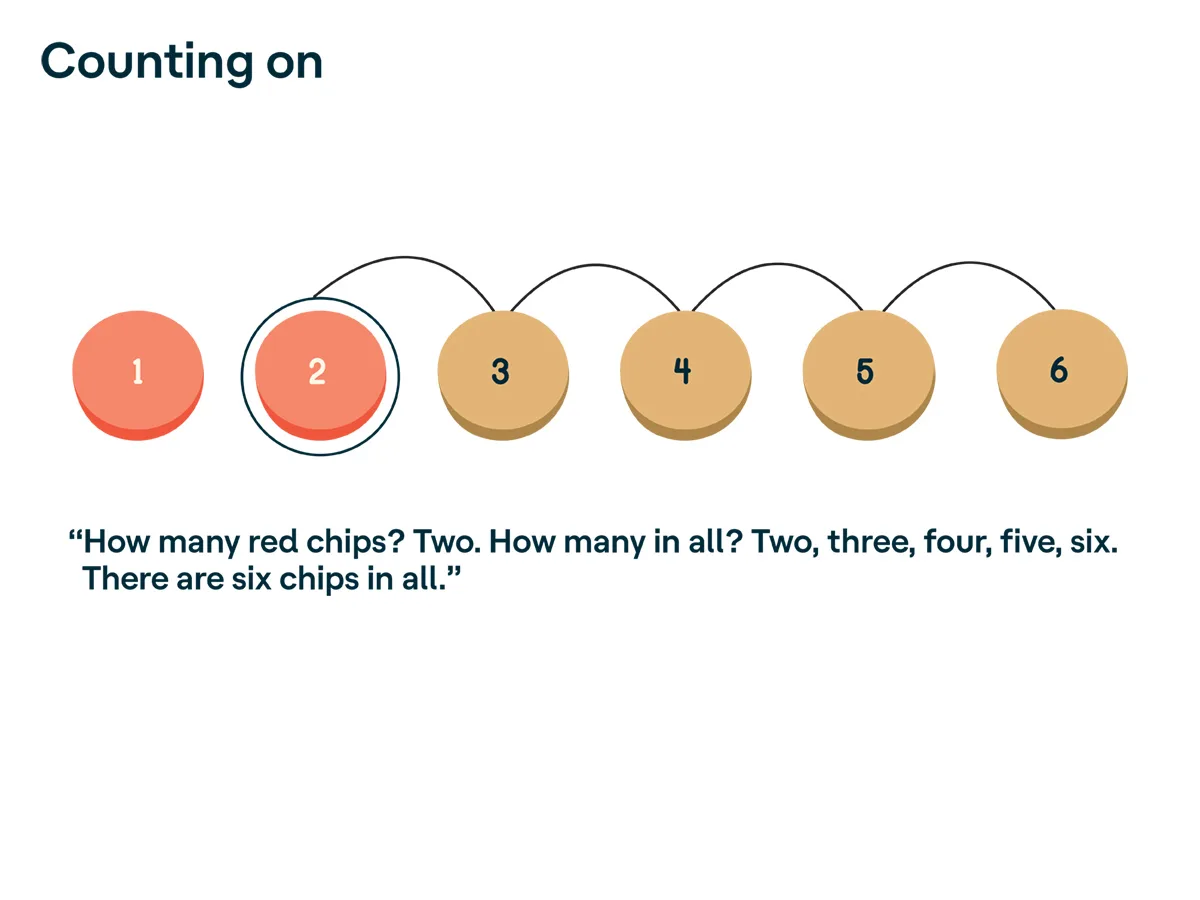Counting with manipulatives to learn addition: An evidence-based math strategy

Many students have difficulty understanding that they can combine two separate numbers to make a quantity that is greater. Counting with manipulatives is a great way to help students learn to add numbers together. With this strategy, you'll use explicit instruction to help students in kindergarten learn to add by using their counting skills. The two methods you’ll use are called “counting all” and “counting on.”
When using the “counting all” strategy, students will count the objects in two sets of manipulatives, and then they’ll combine the sets and count all of the manipulatives together as one whole set.
Next, students will move on to the more efficient “counting on” strategy. It uses a combination of counting and subitizing (quickly naming the number of objects in a set without having to count). They’ll start by subitizing or identifying at a glance how many are in one set and then count on to the next set to reach the total. This is an important step in moving toward identifying two numbers and combining them without counting. Counting all and counting on are two ways of interpreting addition. Both interpretations are essential and students will use them across grade levels.
Read: How to use this counting strategy
Objective: Students will use manipulatives in order to demonstrate counting all and counting on as strategies to combine two addends.
Grade levels (with standards):
K (Common Core K.CC.A.2: Count forward beginning from a given number within the known sequence, instead of having to begin at 1.)
K (Common Core K.CC.B.4.A: When counting objects, say the number names in the standard order, pairing each object with one and only one number name and each number name with one and only one object.)
K (Common Core K.CC.B.4.B: Understand that the last number name said tells the number of objects counted. The number of objects is the same regardless of their arrangement or the order in which they were counted.)
1 (Common Core 1.OA.C.5 Relate counting to addition and subtraction (e.g., by counting on 2 to add 2.)
K–1 (Common Core Math Practice MP7: Look for and make use of structure.)
Best used for instruction with:
Small groups
Individuals
How to prepare:
Gather materials. Each student will need up to 10 manipulatives for counting that come in two different colors. Math “counters” or counting chips work well because they’re easy to set up and move around. They come two-sided like red and yellow or red and white. Another option is to use stacking cubes or colored tiles.
How to teach:
1. Model counting all. Tell students that today they’ll be practicing adding numbers together by using their counting skills. Explain that sets of different color manipulatives will represent each “addend,” or the number being added to another.
Start by modeling how to use the manipulatives to represent numbers using one color. For example, to use counting chips to show the number 3, place three red chips in front of you and count out the pieces. “One, two, three. There are three red chips.” Next, using additional chips, show the students how to use the other side to count the number 2 in a different color. Count out the pieces. “One, two. There are two yellow chips.”
Then say “Let’s add the sets by moving all the chips together.” Line the two sets of chips up in a row. Count all of the pieces. “One, two, three, four, five. There are five chips in all. Three plus two equals five.” Explain that this is the “counting all” strategy for adding. “Now let’s see you give it a try.”

2. Provide guided practice with counting all. Place four red chips and three yellow chips in front of each student. Ask one student to count the red chips. Prompt the other students to follow along by tapping each red chip or sliding them into a row. Next, ask another student to count the yellow chips while the other students follow along. Then, ask each student to add and count them all. “How many chips are there in all? Seven. There are seven chips in all. Four plus three equals seven.”
Continue to practice for additional rounds, changing the addends each time. Students should count out each addend separately, move the manipulatives to one set, and then count the total to themselves. Observe and support the students as needed. Then ask the group to tell you how many chips there are in all. When the students show repeated success, clear the chips and move on to the next counting strategy, “counting on.”
3. Review number sets. Place three red chips on the table for all students to see. Ask a volunteer to tell you how many chips are on the table without counting them one by one. When the student gives an answer, ask them to prove it by counting. Repeat with several different numbers to give other students a chance to try. The goal is to remind students that they can recognize the number of objects in a set without having to count them (subitizing).
Teaching tip: If a student is struggling with subitizing, put the chips inside a ten-frame to help them visualize the number. Repeated practice with ten-frames will help build confidence in identifying numbers as they compare to a group of 10.
4. Model counting on. Place five red chips and three yellow chips in a row on the table. Use your hand or a piece of paper to hide the yellow chips and say “five” while pointing toward the red chips. Then unveil the yellow chips and count on. Point to each yellow chip to emphasize the counting of each one: “Six, seven, eight. There are eight chips in all. Five plus three equals eight.” Explain that with this strategy you do not count all of the chips. Instead, you name the quantity in the first set and count on from that number. Make sure to emphasize the counting on.
Then say “Let’s try it again.” Place two red chips and four yellow chips on the table. This time ask a student to identify the number of red chips without counting. When the student says “two” repeat it out loud and then count on. “Three, four, five, six. There are six chips in all. Two plus four equals six.”

5. Provide guided practice with counting on. Place three red chips and four yellow chips in front of each student. Ask each student to name the number of red chips and then practice counting on to get the total. Check in with each student. For more practice, change the addends and repeat.
For students showing repeated success, challenge them to identify the larger addend first. For example, if there are two red chips and four yellow chips, students should start by saying “four” and then count the red. “Five, six. There are six chips in all. Four plus two equals six.” Some students may be confident enough to demonstrate it both ways.
Understand: Why this strategy works
When students learn to add, they use a combination of counting strategies and subitizing. Practicing counting all and counting on with manipulatives helps students develop these skills.
These methods build on important skills, like naming and representing numbers and applying rote counting and one-to-one correspondence. All these skills help kindergartners begin to understand the number line and learn addition.
By starting with a review of counting all, students gain confidence with addition while using manipulatives. Then, through modeling and guided practice, they move on to the more efficient strategy of counting on. Counting on is the join interpretation of addition. This helps them continue to build their understanding of the counting principles needed for addition.
This strategy also helps students understand the concept of addition through concrete-representational-abstract (CRA), an evidence-based instructional approach. CRA uses visual representations to help students understand abstract math concepts. These representations can be especially helpful for students who learn and think differently, as well as English language learners. By using manipulatives like counting chips, students build their number sense in the concrete stage. Later, students will move to the use of picture representations to complete similar tasks. This will help them work toward fluently using abstract written numbers and symbols, like 2 + 4 = 6.
Connect: Link school to home
Families can practice these counting strategies at home with their kids. Because families may not be familiar with counting all and counting on, it's important to explain the strategies to them. Consider creating and sharing a video to demonstrate the strategies. Provide a list of ideas for counting manipulatives that families may have at home (see “Adapt: Use for Distance Learning” below for suggestions).
Board games like Hi Ho Cherry-O are also a great way for families to practice counting together. Additionally, kids can practice at home with online learning games or apps. Some games that are free to try are Tiggly Chef: Preschool Math Cooking Game or Moose Math by Duck Duck Moose.



